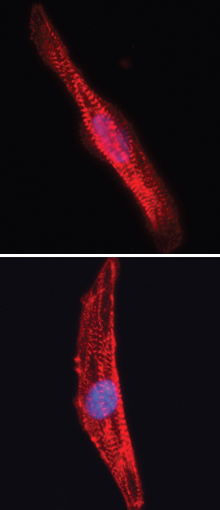기술동향
Patient-Derived Heart Cells Mimic Disease
- 등록일2011-02-16
- 조회수6510
- 분류기술동향
-
자료발간일
2011-02-11
-
출처
Technology review
- 원문링크
-
키워드
#heart#disease#cell
Patient-Derived Heart Cells Mimic Disease
The cells point to new potential therapies for an inherited heart defect
Beating balls of heart cells created from skin biopsies of children with a rare inherited disorder called Timothy syndrome replicate the abnormal heart rhythms that characterize the disease. The cells provide a new way to search for drugs to treat the disease, which is linked to autism and serious—sometimes fatal—heart problems.
Researchers have already identified one compound that normalizes heart rhythms in cells growing in a dish. In addition to benefiting research into Timothy syndrome, the cells might be useful for detecting drug compounds that trigger or exacerbate abnormal heart rhythms, one of the most common reasons for drugs to be pulled off the market.

Broken hearts: Comparing cardiac-muscle tissue (red) derived from induced pluripotent stem cells (iPS cells) taken from healthy people (top) and from children with a heart disorder called Timothy syndrome (bottom) reveals that diseased cells have a greater concentration of calcium (blue).
The findings, published Thursday in Nature, are part of a growing trend to create stem cells from patients with specific diseases, such as heart disease, neurodegenerative disorders, and developmental disorders, and use these cells to recreate the disease of interest in a dish.
Although scientists have previously created cells from people with Down syndrome, ALS, diabetes, and inherited forms of heart disease related to Timothy syndrome, this study is among the first to use the cells to screen compounds intended to reverse the defects seen in the cells.
"Even though we know the gene mutation for many of these diseases, people haven't always connected the dots in terms of how the mutation leads to the arrhythmia [abnormal heart rhythm]," says Michael Laflamme, a physician-scientist in the Center for Cardiovascular Biology at the University of Washington, who was not involved in the study. "That's where these cells come in."
Ricardo Dolmetsch, a neurobiologist at Stanford, and collaborators collected skin cells from two young patients with Timothy syndrome and returned them to a stem-cell state with a technique called induced pluripotent stem (iPS) cell reprogramming. Like embryonic stem cells, iPS cells can be differentiated into any type of tissue, making them a potential source of tissue for drug screening and perhaps tissue-replacement therapies.
The researchers treated the stem cells with chemicals to prod them to develop into heart tissue. After growing for about a month in a dish, the cells developed into beating masses of tissue made of each of the three cell types in the heart; atrial, ventricular, and nodal cells. When the cells are made from people with normal hearts, "they beat beautifully at 60 beats per minute, just like human hearts," says Dolmetsch. However, when derived from stem cells created from patients with cardiac disease, they beat more slowly and missed certain beats, he says. "Something is clearly wrong with them."
.....(계속)
☞ 자세한 내용은 내용바로가기를 이용하시기 바랍니다.
지식
동향

